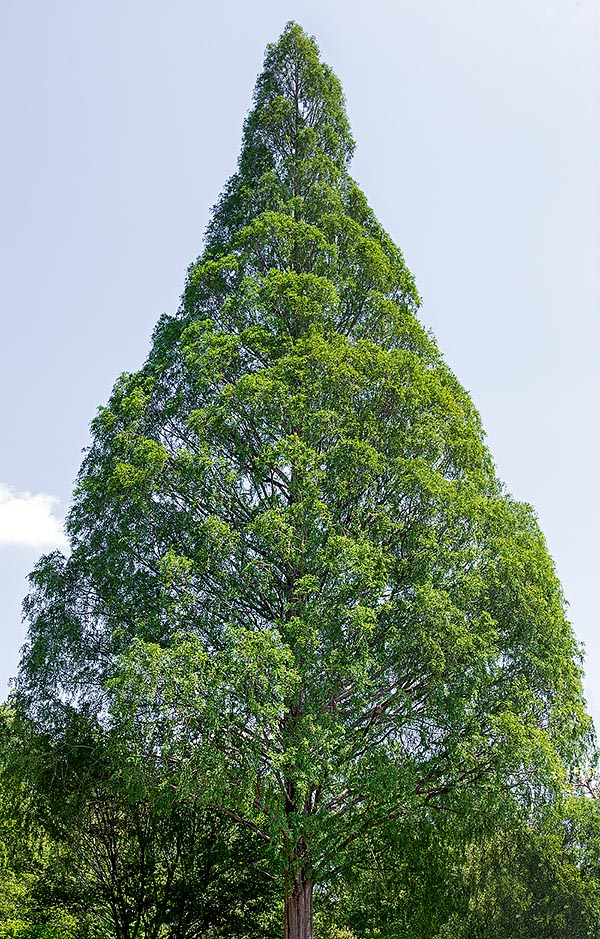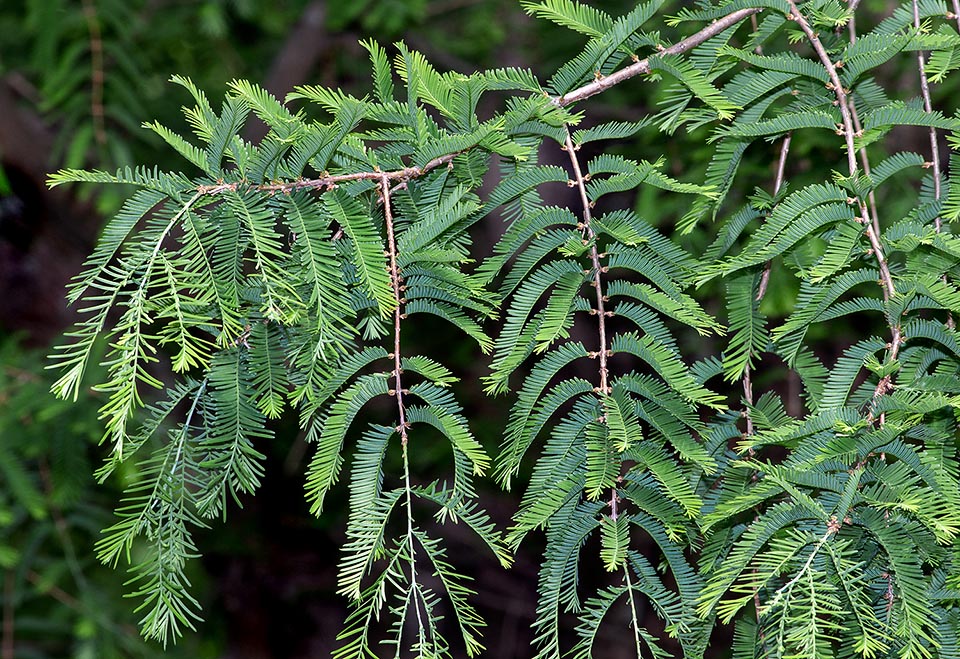Family : Cupressaceae

Text © Pietro Puccio

English translation by Mario Beltramini

The crown of the Metasequoia glyptostroboides, conical before, then cylindrical, may reach the 50 m © Giuseppe Mazza
The species is native to China (Chongqing, Hibei and Hunan) where it lives in the mesophyllic mixed forest in the bottom of the valleys and in the ravines at the margins of water streams, on slightly acidic to neutral soils, between 700 and 1500 m of altitude.
The name of the genus is the combination of the Greek prefix “μετά” (meta), with the meaning of alike, similar, and Sequoia Endl. (1847); the specific name is the combination of the name of the genus Glyptostrobus and of the Greek suffix “-οειδής” (-oeidés), from “εἶδος“ (êidos) = shape, look, hence resembling.
Common names: dawn redwood, dinosaur-age tree, living fossil, water fir (English); shui shan (Chinese); abete d’acqua (Italian); secuoya de hojas caedizas (Spanish).
The Metasequoia glyptostroboides Hu & W.C.Cheng (1948) is a monoecious, deciduous tree, 30-50 m tall with a diameter, at 1,5 m from the soil, up to 2,5 m, provided at the base of tabular roots (flattened roots similar to buttresses), with crown initially conical, then almost cylindrical, and brown-orange bark in the young plants tending with the time to turn dark reddish brown and to crake and flake.
Ascending main branches, persistent secondary ones with alternate leaves and opposite small branches, hanging, deciduous, 5-15 cm long, in their turn provided of 20-40 pairs of opposite leaves, distichous, morbid, spaced 2-5 mm, linear with obtuse apex, 8-20 mm long and 1-2 mm broad, of bluish green or yellowish green colour more intense above, that in autumn turn red or orange before falling together with the small branches.
In summer, on the persistent secondary branches, at the base of the junction of the deciduous small branches, develop the cones. Numerous male cones, arranged in racemes or panicles 20-25 cm long, ovoidal, 2,5-5,5 mm long and of 2-4 mm of diameter, with ovate or obovate scales 4 mm long and 3 mm broad. Terminal female cones, on a woody hanging lateral small branch about 3 cm long, initially ellipsoidal, about 9 mm long and of 5 mm of diameter, of green colour, globose when ripe, 1,4-2,5 cm long and of 1,6-2,3 cm of diameter, of blackish purple colour, formed by 20-30 pairs of scales perpendicular to each other (decussate), containing (2)-5-9 ovules, but the 2-3 basal couples and the three apical ones which are sterile. Obovate pale brown seeds, flattened, winged, 5-6 mm long and 4-5 mm broad.
It reproduces by cutting, taken from young plants, and more quickly by seed, that does not need any cold stratification, placed on draining organic soil maintained constantly humid and covered by a thin layer of siliceous sand, with germination times of about one week.
The discovery of this new species in the central provinces of China, then recognized to belong to a genus extinct since millions of years, is considered as one of the most impostant botanical discoveries of the XX century.
In brief, on 1941, while examining the fossil findings dating back to the Lower Pliocene found in the island of Honshu, the largest of Japan, deemed hitherto as belonging to two extinct species of the genus Sequoia Endl. (1847), the Japanese paleobotanist Shigeru Miki (1901-1971) did notice differences such to justify the institution of a new similar genus he called Metasequoia. Then was evident the link with fossil findings discovered in North America, that prove the great diffusion of the genus in the Tertiary period in the northern hemisphere. For that which has revealed later to be an extraordinary coincidence, on the same year, a Chinese scholar of Nanjing University, T Kan, while travelling in the central provinces, noted at the roadside in Mou-tao-chi (by that time in the Province of Sichuan, nowadays of Hubei) a majestic tree, deciduous, that was called by the inhabitants of the place shui shan (water fir) with characteristics not matching with those of species he knew, of which, however, he could not collect samples being in the winter season.

The discovery in central provinces of China of this new species, later on recognized as belonging to a genus extinct since millions of years, is considered as one of the most important botanical discoveries of the XX century. Introduced in Europe and America in 1948, it grows quickly and well in the temperate and humid continental climates © Giuseppe Mazza
In 1944 a professor of the Forestry Department of the Forest Research Centre, Tzhan Wang (1911-2000), collected some samples from the tree and identified them as Glyptostrobus pensilis (Staunton ex D.Don) K.Koch (1873), these samples were examined in 1945 by an assistant to the same Department, C.H. Wu, who deemed them to belong to a genus of conifers till then unknown, of the same opinion was the professor Wan-Chun Cheng (1904-1983) and the professor Hsen Hsu Hu (1894-1968) of Beijng Fan Memorial Institute of Biology, who, knowing the article published by S. Miki about the Metasequoia realized that the samples represented the same plant as the fossil findings of Japan.
In 1946 two expeditions were organized for finding new specimens, collect other samples and fresh seeds, and another one, lasted three months, organized with the financial support of the Arnold Arboretum (Harvard University). On the base of the material collected the professors Cheng and Hu did officially describe in 1948 the new species. In the same year several seeds were sent to the Arnold Arboretum, a part of which was sown in the spot and the remainder given to scientific organizations of the whole world.
Regardless of the charm of its discovery, it is a particularly ornamental species and from its introduction in Europe and in America, has met an ever greater interest. Fast growing, it lives well in the temperate and humid continental climates, where it can stand temperatures up to about -20 °C, with an annual rainfall over the 1000 mm, conversely, does not love the climates with warm and dry summers, like those of Mediterranean type. It needs deep and fertile soils maintained constantly humid, but without prolonged water stagnations, the young plants are to be irrigated during prolonged dry periods.
Due to the considerable fragmentation of the existing population and the gradual reduction of the number of individuals, the species, now protected by the local authorities, has been placed in the red list of the IUCN (International Union for Conservation of Nature) among the species at very high risk of extinction in the next future (“Endangered”).
Synonyms: Sequoia glyptostroboides (Hu & W.C.Cheng) Weide (1962); Metasequoia glyptostroboides var. caespitosa Y.H.Long & Y.Wu (1984); Metasequoia honshuenensis Silba & Callahan (2000); Metasequoia neopangaea Silba (2002); Metasequoia glyptostroboides subsp. caespitosa (Y.H.Long & Y.Wu) Silba (2010); Metasequoia glyptostroboides subsp. neopangaea (Silba) Silba (2010).
→ To appreciate the biodiversity within the CUPRESSACEAE family please click here.
